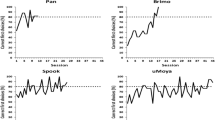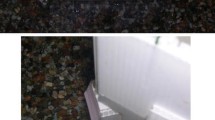Abstract
Stereokinetic illusions have never been investigated in non-human primates, nor in other mammalian species. These illusions consist in the perception of a 3D solid object when certain 2D stimuli are rotated slowly in the plane perpendicular to the line of sight. The ability to perceive the stereokinetic illusion was investigated in the common marmoset (Callithrix jacchus). Four adult marmosets were trained to discriminate between a solid cylinder and a solid cone for food reward. Once learning criterion was reached, the marmosets were tested in sets of eight probe trials in which the two solid objects used at training were replaced by two rotating 2D stimuli. Only one of these stimuli produced, at least to the human observer, the stereokinetic illusion corresponding to the solid object previously reinforced. At test, the general behaviour and the total time spent by the marmosets observing each stimulus were recorded. The subjects stayed longer near the stimulus producing the stereokinetic illusion corresponding to the solid object reinforced at training than they did near the illusion corresponding to the previously non-rewarded stimulus. Hence, the common marmosets behaved as if they could perceive stereokinetic illusions.


Similar content being viewed by others
References
Barbet I, Fagot J (2002) Perception of the corridor illusion by baboons (Papio papio). Behav Brain Res 132:111–115
Bayne KAL, Davis RT (1983) Susceptibility of rhesus monkey (Macaca mulatta) to the Ponzo Illusion. Bull Psychonom Soc 21:476–478
Bressan P, Vallortigara G (1987) Learning to see stereokinetic effects. Perception 16:187–192
Clara E, Regolin L, Vallortigara G, Zanforlin M (2006) Domestic chicks perceive stereokinetic illusions. Perception 35:983–992
Deruelle C, Barbet I, Depsy D, Fagot J (2000) Perception of partly occluded figures by baboons (Papio papio). Perception 29:1483–1497
Dittrich WH, Lea SEG (1993) Motion as a natural category for pigeons: generalization and a feature-positive effect. J Exp Anal Behav 59:115–129
Emmerton J (1986) The pigeon's discrimination of movement patterns (Lissajous figures) and contour-dependent rotational invariance. Perception 15:573–588
Fujita K, Blough DS, Blough PM (1991) Pigeons see the Ponzo illusion. Anim Learn Behav 19:283–293
Kaplan G, Rogers LJ (1999) Parental care in marmosets (Callithrix jacchus jacchus): development and effect of anogenital licking on exploration. J Comp Psychol 113:269–276
Menzel CR (1980) Head cocking and visual perception in primates. Anim Behav 28:151–159
Musatti CL (1924) Sui fenomeni stereocinetici. Arch Ital Psicol 3:105–120
Musatti CL (1975) Stereokinetic phenomena and their interpretation. In: Flores D’Arcais GB (ed) Studies in perception. Festschrift for Fabio Metalli. Martello-Giunti, Milan, pp 166–189
Nagasaka Y, Hori K, Osada Y (2005) Perceptual grouping in pigeons. Perception 34:625–632
Nieder A (2002) Seeing more than meets the eye: processing of illusory contours in animals. J Comp Physiol A Neuroethol Sens Neural Behav Physiol 188:249–260
Perrett DI, Harries MH, Benson PJ, Chitty AJ, Mistlin AJ (1990) Retrieval of structure from rigid and biological motion: an analysis of the visual responses of neurones in the macaque temporal cortex. In: Blake A, Troscianko T (eds) I and the eye. Wiley, Chichester, UK, pp 181–201
Regolin L, Vallortigara G (1995) Perception of partly occluded objects by young chicks. Percept Psychophys 57:971–976
Rokers B, Fang F, Pan H, Bly BM, Liu Z (2001) The time course in perceptual organization: an EEG study. Vision Sciences Society, Sarasota, FL
Siegel RM, Andersen RA (1988) Perception of three-dimensional structure from visual motion in monkey and man. Nature 331:259–261
Timney B, Keil K (1996) Horses are sensitive to pictorial depth cues. Perception 25: 1121–1128
Ullman S (1979) The interpretation of visual motion. MIT Press, Cambridge, MA
Ullman S (1984) Maximizing rigidity: the incremental recovery of 3-D structure from rigid and rubbery motion. Perception 13:255–274
Vallortigara G, Bressan P, Bertamini M (1988) Perceptual alternations in stereokinesis. Perception 17:31–34
Vallortigara G, Bressan P, Zanforlin M (1986) The Saturn illusion: A new stereokinetic effect. Vision Res 26:811–813
Wallach H, O’Connell DN (1953) The kinetic depth effect. J Exp Psychol 45(4):205-217
Wilson JA, Robinson JO, Piggins DJ (1983) Wobble cones and wobble holes: the stereokinetic effect revisited. Perception 12(2):187–193
Zanforlin M (1987) La determinazione teorica del cono stereocinetico di Musatti. Att. Mem. Accad. Patav. SSLLAA 99:33–46
Zanforlin M (1988) The height of a stereokinetic cone: a quantitative determination of a 3-D effect from 2-D moving patterns without a “rigidity assumption”. Psychol Res 50:62–172
Zanforlin M, Vallortigara G (1988) Depth effect from a rotating line of constant length. Percept Psychophys 44:493–499
Zivotofsky AZ, Golberg ME, Powell KD (2005) Rhesus monkey behave as if they perceive the Duncker illusion. J Cogn Neurosci 17(7):1011–1017
Acknowledgements
This research was carried out during a 10-month research period spent by E.C. at the University of New England, and she is grateful for support given by an Endeavour Australian-Europe Award from the Australian Department of Education, Science and Training (DEST) and to funding from the Faculty of Science at the University of New England. Research costs were funded by an Australian Research Council grant to L.J.R. No invasive procedures were used and the experimental and housing conditions of the marmosets were in accordance with the principles and regulations of the Australian Code of Practice for the Care and Use of Animals for Scientific Purposes (1997) and approved by the Animal Ethics Committee at the University of New England.
Author information
Authors and Affiliations
Corresponding author
Rights and permissions
About this article
Cite this article
Clara, E., Regolin, L., Vallortigara, G. et al. Perception of the stereokinetic illusion by the common marmoset (Callithrix jacchus). Anim Cogn 10, 135–140 (2007). https://doi.org/10.1007/s10071-006-0046-3
Received:
Revised:
Accepted:
Published:
Issue Date:
DOI: https://doi.org/10.1007/s10071-006-0046-3




